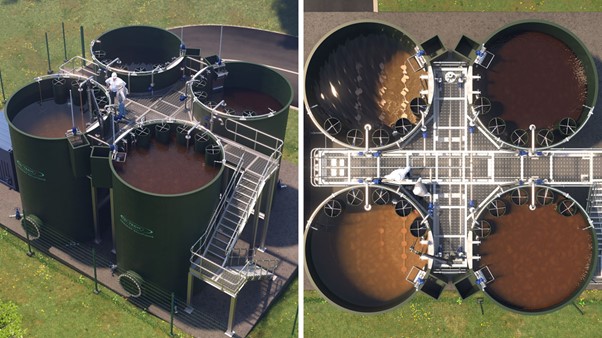In the summer of 2024, Ofwat set out a record £88 billion plan for water companies to upgrade and deliver cleaner rivers and seas, as well as better services for customers.
Of this, £6 billion has been allocated for improvements of over 1,500 wastewater treatment works which will see around 880 of the works removing more phosphorus. Phosphorus mitigation is one of many key focuses of the AMP8 water management plan which will run from 2025–2030.
The aim is to improve the UK’s river water quality and meet targets set out in the Environment Act 2021 – reducing the amount of phosphorus in treated wastewater by 80% by 2038, with an interim target to achieve a 50% reduction by 2028.

Why is phosphorus removal so important?
Phosphorus removal is essential to improve river water quality, largely because phosphorus is a key contributor to eutrophication – a process that depletes oxygen in water bodies, leading to degraded aquatic ecosystems and loss of biodiversity.
Elevated phosphorus levels often stem from agricultural runoff, wastewater discharges, and other human activities. Excessive phosphorus accelerates algae growth, which forms dense blooms that block sunlight, disrupt natural habitats, and eventually decay, consuming oxygen and harming fish and other aquatic life.
Potentially toxic algal blooms
Algal blooms, especially those formed by cyanobacteria (commonly known as blue-green algae) can be a major concern for water quality and safety.
When nutrient levels – namely phosphorus and nitrogen – are high in freshwater systems, they create ideal conditions for rapid cyanobacterial growth, leading to the formation of “blooms.”
These blooms are easily recognisable as they often turn the water a vibrant green and form dense surface scums, especially near shorelines.
Cyanobacteria are known to produce cyanotoxins, potent compounds that pose serious health risks.
Contact with or ingestion of water containing these toxins can result in a range of health effects, from minor skin rashes and eye irritation to severe gastrointestinal symptoms, liver damage, and, in extreme cases, even death.
Cyanotoxins also affect wildlife, particularly aquatic organisms and animals that drink from contaminated water bodies, amplifying the ecological impact.
Phosphorus removal in AMP8
Preventing algal blooms, including those composed of cyanobacteria, requires strategies that reduce nutrient loading, including controlling agricultural run-off and investing in wastewater treatment technology and natured-based solutions, such as wetlands.
There are three main strategies when it comes to phosphorus removal:
- Nature-based solutions
- Biological removal
- Chemical precipitation
Phosphorus limits for wastewater treatment works in AMP8 are as low as 0.2mg/l, and even lower for Sites of Special Scientific Interest (SSSIs) e.g. in areas like the Lake District – here limits can be as low as 0.1mg/l.
Nature-based solutions
Constructed wetlands offer a sustainable way to remove phosphorus from wastewater. These manmade ecosystems mimic natural wetlands, using plants, soil, microbes and substrates to filter out pollutants.
Wetlands remove phosphorus and other nutrients through a combination of physical, chemical, and biological processes. These naturally occurring processes absorb, adsorb, transform, and remove nutrients and other chemicals as water flows through the wetland. This reduces the nutrient load before it reaches rivers and lakes.
Wetlands are not only effective but resilient, creating habitats and boosting biodiversity, all while helping wastewater treatment works meet stringent regulations. This nature-inspired approach combines environmental restoration with practical water management, making it a win-win solution for phosphorus control.

Nature-based problems
But constructed wetlands face challenges. They require significant space. Land is costly and this makes initial setup expensive. Careful planning, excavation, and planting, alongside ongoing monitoring and management to ensure effectiveness, add to operational costs.
It’s not applicable for facilities with limited space or budget and can be less feasible than other treatment options.
Chemical precipitation
Chemical phosphorus removal, also known as chemical precipitation or primary phosphorus removal, involves adding a coagulant to wastewater to remove inorganic phosphates.
The most common chemical removal options involve dosing metal salts. This process uses multivalent metal ions – most commonly aluminium, calcium, or iron – to form insoluble phosphorus compounds, which then settle out as sludge.
Steering away from chemical dosing
Chemical dosing comes with a host of issues. For example, ferric is highly corrosive and wreaks havoc with tanks and pipes.
Chemical precipitation also significantly increases sludge volumes, which necessitates tertiary treatment of the precipitates generated – adding unwanted additional costs to the process. Supply chain reliability, huge price fluctuations and quality must also be considered.
Biological phosphorus removal
Biological phosphorus removal is a process used in wastewater treatment that relies on specialised bacteria, known as polyphosphate accumulating organisms (PAOs). The process creates conditions that promote the growth of these beneficial microorganisms that naturally consume phosphorus as a nutrient source.
The process traditionally requires alternating anaerobic and aerobic conditions to encourage the bacteria to take in phosphorus.
Advanced nutrient removal
Innovative nutrient removal technology, called te-cyc™, can meet tightened consent limits, using simultaneous nitrification and denitrification, in combination with biological phosphorus removal.
The biological method does the bulk of the nutrient removal work, and significantly reduces flocculant chemical requirements. Helping to avoid any increased sludge generation and additional operational costs associated with disposal.
The process uses a single-stage batch setup, allowing continuous flow, and eliminating requirements for upstream or downstream buffer tanks. This reduces the overall site footprint and removes the need for mechanical mixing. Therefore, reducing energy costs and offering efficient and sustainable nutrient removal, with fewer chemicals.
The patented technology is used worldwide in over 1,500 sites and is used to treat more than 20 billion litres per day globally. Te-cyc plants are not only effective but also environmentally friendly. And are low energy consumption, using a unique OUR process control, as well as reduced nitrous oxide emission compared to conventional systems.
Efficient, effective and sustainable technology
Te-cyc satisfies multiple drivers simultaneously and provides a lower whole life cost when compared to a conventional upgrade solution.
The cost savings are attributed to reduced infrastructure and space requirements, with no need for anoxic or buffer tanks site footprint is reduced, and fewer chemicals required for dosing.
Delivering clean rivers, lakes and seas by 2030
The question is – can the UK water industry deliver results? Will significant progress be made? And will it be enough to protect and restore the UK’s waterways?
AMP8 will undoubtedly bring us closer to a cleaner, healthier future for our rivers, lakes and seas.
It has serious financial backing, The historic £88 billion investment plan is far greater than the £51 billion outlay during AMP7 and gives the water industry unprecedented resources to deliver tangible improvements, far increasing the likelihood of achieving clear results in terms water quality and aquatic ecosystem health.
But it won’t be phosphorus mitigation schemes alone which will achieve the desired results.
Other key areas will be addressed, such as reducing the number of spills from Combined Sewer Overflows (CSOs).
AMP8 includes targets to reduce spills by 44% (compared with 2021 levels) by spending £10 billion to upgrade 2,500 storm overflows (this includes the 21% reduction which Ofwat has required companies to deliver by 2025 at their own expense).
And the pressure is on. There has been immense public and media scrutiny to deliver the final parts of AMP7, specifically concerning the spillages from CSOs discharging into water bodies. And this scrutiny will only continue when AMP8 begins on 1 April 2025.
So, optimism is aplenty throughout the sector, but only time will tell if we can turn the tide for the UK’s waterways.
